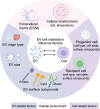A review of the regulatory mechanisms of extracellular vesicles-mediated intercellular communication
- PMID: 37055761
- PMCID: PMC10100201
- DOI: 10.1186/s12964-023-01103-6
A review of the regulatory mechanisms of extracellular vesicles-mediated intercellular communication
Abstract
Extracellular vesicles (EVs) are small, membrane-bound structures that are released from cells into the surrounding environment. These structures can be categorized as exosomes, microvesicles, or apoptotic vesicles, and they play an essential role in intercellular communication. These vesicles are attracting significant clinical interest as they offer the potential for drug delivery, disease diagnosis, and therapeutic intervention. To fully understand the regulation of intercellular communication through EVs, it is essential to investigate the underlying mechanisms. This review aims to provide a summary of the current knowledge on the intercellular communications involved in EV targeting, binding, and uptake, as well as the factors that influence these interactions. These factors include the properties of the EVs, the cellular environment, and the recipient cell. As the field of EV-related intercellular communication continues to expand and techniques improve, we can expect to uncover more information about this complex area, despite the current limitations in our knowledge.
Keywords: EV biogenesis; EV uptake; Exosome; Extracellular vesicle; Intercellular communication.
© 2023. The Author(s).
Conflict of interest statement
The authors declare no competing interests.
Figures



References
-
- Théry C, et al. Minimal information for studies of extracellular vesicles 2018 (MISEV2018): a position statement of the International Society for Extracellular Vesicles and update of the MISEV2014 guidelines. J Extracell Vesicles. 2018;7(1):1535750. doi: 10.1080/20013078.2018.1535750. - DOI - PMC - PubMed
Publication types
MeSH terms
LinkOut - more resources
Full Text Sources
Other Literature Sources
Research Materials

